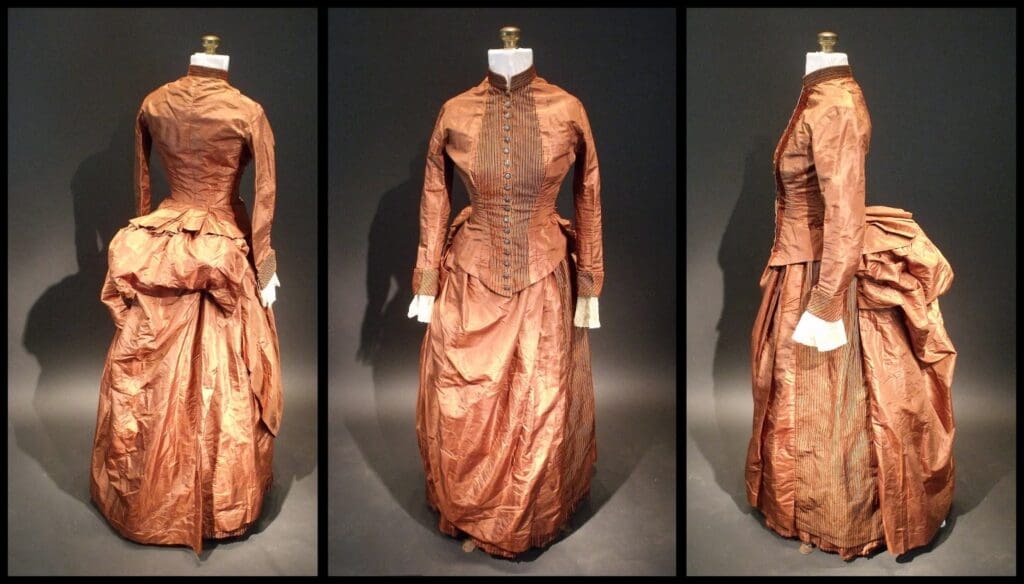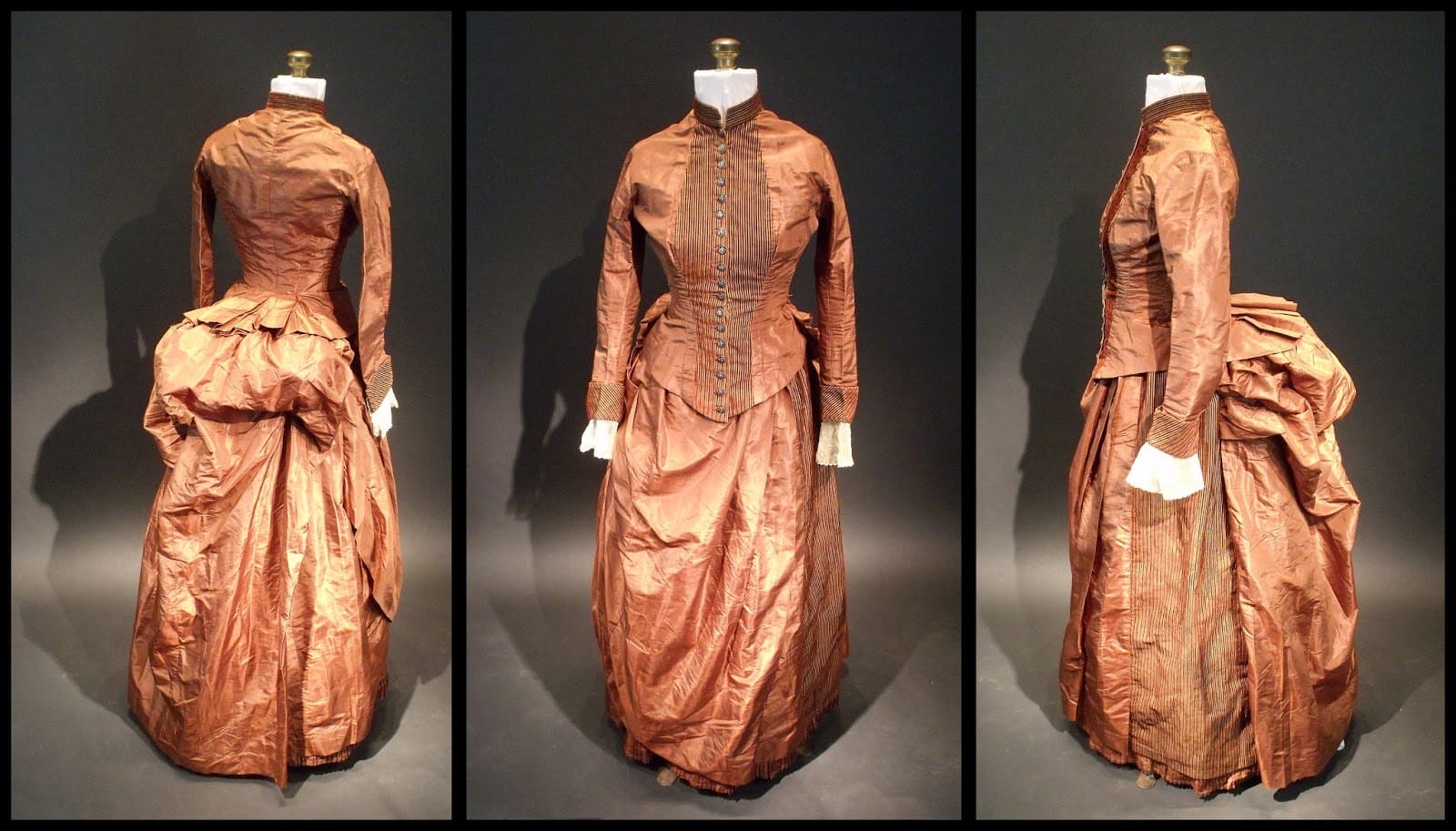
An intriguing discovery was found inside a Victorian dress that was purchased by a woman who is a collector of vintage costumes. It quickly became a full-fledged mystery.
Sara Rivers Cofield is an archeological curator who lives in Chesapeake Beach, Maryland. In December 2013, she visited her mother in Searsport, Maine, and decided to shop at a local antique mall.
Sara spotted a striking dress from the 1880s. It had a fitted bodice, puffy bustle, and lace cuffs. Upon closer inspection, its delicate embroidery, bronze silk, and metallic buttons appeared intact despite its age. She haggled with the store owner and got the price down from $125 to $100. Even at that price, it was a little higher than what Sara normally paid, but being the holiday season, she decided to splurge. Still, the buttons alone were worth more than she’d paid for the dress.
Read More: 3,700-Year-Old Clay Tablet Changes History
Secret Pocket Discovered
Upon taking the dress home, Sara wondered where to store the two-piece garment. Further inspection of the bustle revealed a secret pocket. Inside, Sara found two crumpled sheets of paper that had lists of words and places that appeared at first glance to be random:
Bismark, omit, leafage, buck, bank.
Calgary, Cuba, unguard, confute, duck, Fagan.
There were also notes in the margin that appeared to refer to time.
The dress also had a tag stitched into it with a name handwritten on it: Bennett.
Sara was baffled. Still, she assumed the note had to be important. Why else would “Bennett” need a, in her words to CNN, a “super secret hidey-hole” inside the dress to stash them?
Online Sleuths Worked to Solve the Mystery but Remained Stumped for Years
In February 2014, Sara posted a blog about the dress. She nicknamed the garment “Bennett’s Bronze Bustle.” In her article, she explained her mysterious discovery and encouraged anyone interested in solving the riddle to investigate it.
“I’m putting it up here in case there’s some decoding prodigy out there looking for a project,” Sara wrote.
Sara also included photos of the dress and the notes she discovered inside.
After posting the blog about the dress, Sarah says she didn’t think much about it afterward.
However, unbeknownst to Sara, plenty of curious amateur sleuths took up the task of trying to solve the mystery. “Bennett’s Bronze Bustle” became the “Silk Dress Cryptogram” to the online code breakers. All sorts of conspiracy theories emerged related to the words contained in the notes. Some even speculated that Bennett was perhaps a spy and had used coded words to communicate.
The mystery became so popular online that by 2017, it had been added to one blogger’s list of the Top 50 unsolved encrypted messages. This only floated even more conspiracy theories that ranged from a “cryptic love note” to “Civil War codes.”
Sara herself shot down any possibility that the dress could be linked to the Civil War. She is well-versed in costumes and has studied catalogs from the department store chain Bloomingdale’s from the 1880s. She says she is certain that the dress is from that era. The Civil War had ended some twenty years earlier.
“I had kind of abandoned the blog at that point,” Sara says. “Every once in a while I would see that a comment was posted or that some other codebreaker would email me and be like, ‘Hey, I’m still interested in this,’ but nobody ever solved it.”
2024: The Code Is Finally Cracked
News finally broke in 2024 that a Canadian researcher had cracked the code. Wayne Chan, a researcher at the University of Manitoba in Canada who solves codes as a hobby, first stumbled across the code online in the summer of 2018. He began researching the telegraph era and the weather codes used in North America at the time.
“I worked on it for a few months, but didn’t get anywhere with it,” Chan said. “I set it aside and didn’t look at it again.”
However, all that changed early last year when Chan said he had a breakthrough.
Chan discovered that the coded messages were a weather report. The assumptions that the words were somehow encrypted for secrecy turned out to be false. Instead, this type of shorthand code allowed forecasters to describe detailed weather reports in a few words.
This was the era of the telegraph. As such, shorthand was less expensive than transmitting a big batch of words and temperature readings.
Chan discovered that each word represented meteorological variables. Temperature, wind speed, and barometric pressure at a specific location and time of day.
What Chan discovered was that all encoded messages at the time used a 19th-century telegraphic weather code that was used by the U.S. Army Signal Corps. This essentially served as the National Weather Service for the US during the late 1800s.
In those days, Chan said, all weather stations were required to send their reports by telegraph to a central office in Washington, DC.
“Telegraphic codes were used for two main reasons: secrecy and economy,” Chan told CNN. “This particular code was not meant for secrecy at all. The weather code was for the latter. “
“Because you were charged by the word in a telegram, they wanted to shorten or compress a weather report into as few words as possible to save on costs,” Chan continued. “The words were arranged so that particular consonant-vowel pairs represented specific numerical values.”
“It was really a very complex code, even though the intent was not for secrecy,” Chan added.
What Did the Mysterious Note Say?
Let’s look at the note with the cryptic line: Bismark Omit leafage buck bank
Chan was able to work out how this shorthand described surprisingly specific details.
“Bismark,” referred to the weather data being recorded at Bismarck station in what is now North Dakota.
“Omit” referred to an air temperature of 56 degrees and the bear might pressure was 0.08 inches of mercury.
“Leafage” referred to a dewpoint of 32°F observed at 10 PM.
“Buck” indicated there was no precipitation.
“Bank” meant a wind velocity of 12 mph and a clear sunset.
Chan even pinpointed the weather report in the note to the exact day.
The National Oceanic and Atmospheric Administration (NOAA) provided old weather maps that helped him determine the precise date of the weather observations in the coded note: May 27, 1888.
Chan then went on to write an academic paper explaining the topic, as well as emailing Sarah Rivers Cofield to inform her of the revelation.





